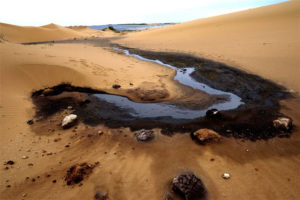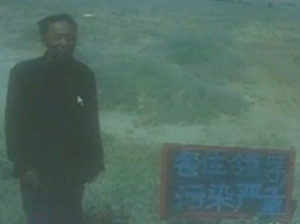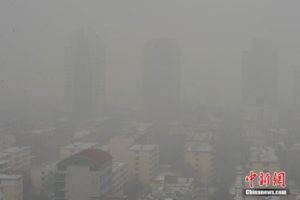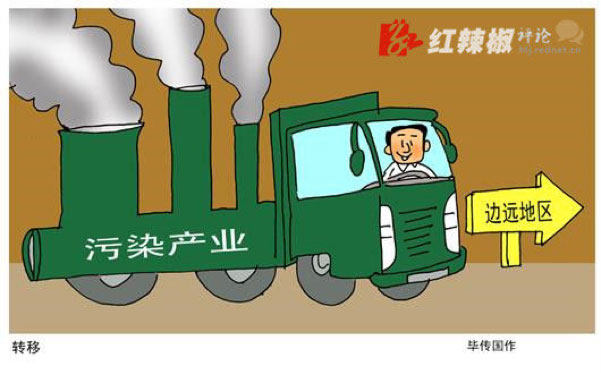In Mongolian, Tengger means both ‘heaven’ and ‘huge’. Most of China’s Tengger Desert 腾格里沙漠 falls in Inner Mongolia, but it also extends into the northwestern provinces of Ningxia and Gansu. At 36.7 thousand square kilometres, it is China’s fourth largest desert. It is dotted with hundreds of freshwater lakes surrounded by fertile areas of grass and vegetation that have sustained nomadic herders and their animals for thousands of years.
However, beginning in the late 1990s, the local governments of Inner Mongolia and Ningxia have been building industrial parks in the desert, including many chemical manufacturing plants. These enterprises discharge untreated wastewater into the desert, polluting groundwater resources and destroying desert ecosystems, threatening the survival of local herders, their families, and their animals.
The local people’s complaints have fallen on deaf ears. In 2011, after one herder, Urhaan, failed to get any meaningful response from local government, he erected a board by a road near to his home on which he wrote: ‘Dear leaders, the pollution is serious!’ 各位领导, 污染严重.
![Pollution of the Tengger Desert Photo: [Clockwise from top left] People’s Daily; Bert van Dijk/Flickr; wzaobao.com; and chinadialogue.net](https://www.thechinastory.org/content/uploads/2016/09/02f-pollution-tengger.jpg)
Pollution of the Tengger Desert
Photo: [Clockwise from top left] People’s Daily; Bert van Dijk/Flickr; wzaobao.com; and chinadialogue.net
Journalists were aware of the issue. In 2011, the Times Weekly 时代周报 reported on it in detail. Two years later, on the UN-sponsored World Water Day (22 March), China Central Television (CCTV) broadcast a report they titled ‘abscess in the desert’.
Yet nothing changed until September 2014, when two influential news media organizations, The Beijing News 新京报 and the Southern Weekend 南方周末 fiercely criticised the local authorities for their inaction. Soon after that, the central leadership stepped in. Xi Jinping and other central leaders ordered the party committees and government of the Inner Mongolian autonomous region to halt the pollution of the Tengger Desert.

7 May 2015: the Ming Sheng Dyeing Company was fined five million yuan for breaching the environmental law
Photo: Xinhua
The Supreme People’s Procuratorate of China, meanwhile, investigated criminal breaches of environmental law, listing four ‘key’ cases from Inner Mongolia, Ningxia, and Gansu. On 7 May 2015, it fined the Ming Sheng Dyeing Company 明盛染化公司 five million yuan, additionally fining Lian Xinzhong 廉兴中, the company’s responsible executive, fifty thousand yuan and giving him a suspended sentence of eighteen months. This was named one of the ‘hottest’ ten cases of the year by Sina.com’s news centre. Comments on the Chinese Internet noted the absurdity of the authorities having to wait for an instruction from the highest leadership before acting.
Worse, more and more polluting industries are relocating to remote parts of western China with the apparent intention of avoiding the increasingly stringent anti-pollution measures in economically developed regions of the east—a phenomenon dubbed Pollution Migrates to the West 污染西迁. Indeed, on 17 November 2015, official media announced that between 2013–2015, Beijing had successfully eliminated 1,006 of its polluting enterprises. The report did not say where these enterprises had gone. A year earlier, when a person in Inner Mongolia posted his fears that they were simply moving to Inner Mongolia, he was detained by local police for ten days and fined 500 yuan for ‘spreading rumours’.
In May 2015, when I was in Inner Mongolia, I heard many people voice their fears that the number of power plants being built there meant ‘you will never see the sun again in the grasslands’. I heard some say that ‘Inner Mongolian people are like candles, burning themselves to provide illumination for others’, referring to the fact that coal-fired electricity is produced in Inner Mongolia for use in Beijing and elsewhere.
These rumours, if that’s what they are, are not totally groundless. As early as 2013, the National Business Daily 每日经济新闻 reported that while the Air Pollution Prevention Action Plan restricted the building of new coal-fired power projects in eastern regions such as Jing-Jin-Ji (See Chapter 5 ‘The City that Ate China—Restructuing and Reviving Beijing, pp.178–201), they were springing up in western provinces including Shanxi, Shaanxi, Inner Mongolia, and Ningxia. According to China Energy News 中国能源报, 120 new plants have been approved (another source says 155), of which forty-eight are to be located in western China and seventeen of these in Inner Mongolia.
Already, Asia’s largest coal-fired power plant is located close to Hohhot, the capital city of Inner Mongolia, which is already plagued with heavy smog in winter. Built in 1995, its main task according to Wang Dongsheng 王东升, the party secretary, in 2015, is to ‘ensure power supply to Beijing without polluting Inner Mongolia’. If you substitute ‘western China’ for
‘Inner Mongolia’, that is the challenge in a nutshell.
Notes — Pollution Migrates to the West
‘Polluting the desert: how terrible it is?’ 沙漠污染有多可怕?, baike.com, 8 October 2014, online at: http://toutiao.baike.com/article-1571987.html
‘How to govern underground pollution?’ 地下排污, 如何治理?, blog.163.com, 26 February 2012, online at: http://blog.163.com/special/0012646O/underearthpollution.html
‘Desert abscess’ 沙漠里的“脓疮”, Tencent, 22 March 2013, online at: http://v.qq.com/page/a/7/0/a0012s5d670.html
‘Desert shame’ 沙漠之殇, The Beijing News, 6 September 2014, online at: http://epaper.bjnews.com.cn/html/2014-09/06/content_533715.htm?div=-1; Shao Wenjie 邵文杰, ‘Why the Tengger industrial zone is incorrigible?’ 腾格里工业圆为何屡教不改, infzm.com, 12 September 2014, online at: http://www.infzm.com/content/104078
‘Inner Mongolia plans for environmental protection to stop Tengger Desert pollution’ 内蒙古安排部署生态环境保护工作, 处置腾格里污染物, Xinhua, 3 October 2014, online at: http://www.nmg.xinhuanet.com/xwzx/2014-10/03/c_1112709680.htm
‘The Supreme Procuratorate supervises four environmental pollution cases in Tengger Desert; four officials being investigated for suspected dereliction of duty’ 最高检挂牌督办4起腾格里沙漠污染环境案4公职人员涉嫌渎职犯罪被查, Xinhua, 22 May 2015, online at: http://news.xinhuanet.com/legal/2015-05/22/c_127831851.htm
‘Tengger Desert’s first environmental pollution case verdict’ 腾格里沙漠污染首例环境污染案一审宣判, Legaldaily.com.cn, 7 May 2015, online at: http://www.legaldaily.com.cn/Court/content/2015-05/07/content_6072610.htm
‘Tengger Desert pollution: Do not always bother Uncle Xi’ 腾格里沙漠污染这种事,不要总是麻烦习大大, Guancha zhe, 5 October, 2014, online at: http://www.guancha.cn/politics/2014_10_05_273286.shtml
‘Pollution migrates west’ 污染 “西迁”, NetEase, 9 September 2014, online at: http://news.163.com/14/0909/02/A5LUCN6B00014Q4P.html
‘Beijing closed down 326 polluting enterprises this year compared with the annual goal of 300’ 北京今年关停326家污染企业, 提前完成淘汰300家年度任务, Chinaso.com, 26 December 2015, online at: http://finance.chinaso.com/detail/20151226/1000200032880141451088227225557402_1.html
‘Ministry of Environment refines coal control target in Beijing, Tianjin, Hebei and Shandong provinces; obvious trend to westward migration of power plants’ 环境部细化京津冀鲁控煤目标, 火电厂西迁趋势明显, nbd.com.cn, 23 September 2013, online at: http://www.nbd.com.cn/articles/2013-09-23/775190.html
‘Over hundred coal-fired power plants approved in 25 provinces in first 11 months of 2015’ 前11个月25省市核准火电项目过百, EMCA, 10 December 2015, online at: http://news.emca.cn/n/20151210101646.html; ‘Optimistic investment on coal-fired power projects; explosive growth of coal-fired power plant approval’火电项目投资回暖, 火电审批爆发式增长, Ocn.com.cn, 16 January 2016, online at: http://www.ocn.com.cn/chanjing/201601/lcuci11120026.shtml; ‘Inner Mongolia approved 17 coal-fired power plants’ 内蒙古核准17个火电项目, Bjx.com.cn, 6 September 2015, online at: http://news.bjx.com.cn/html/20150906/660186.shtml
‘Listen to a “green life story” of the boss of coal-fired industries at Togtog power plant of China Datang Corporation’ 走进大唐托电: 倾听火电老大的“环保人生”, People.cn, 12 August 2015, online at, http://nm.people.com.cn/n/2015/0812/c196689-25953800.html





